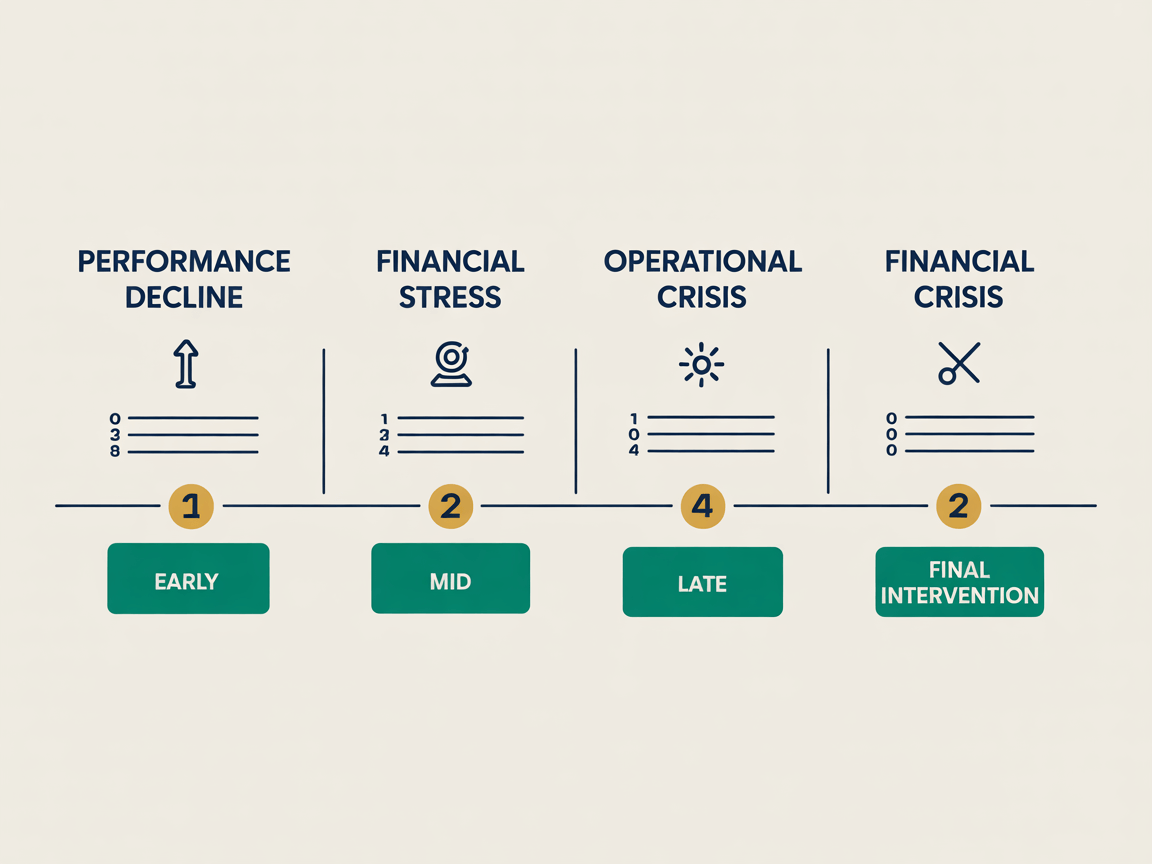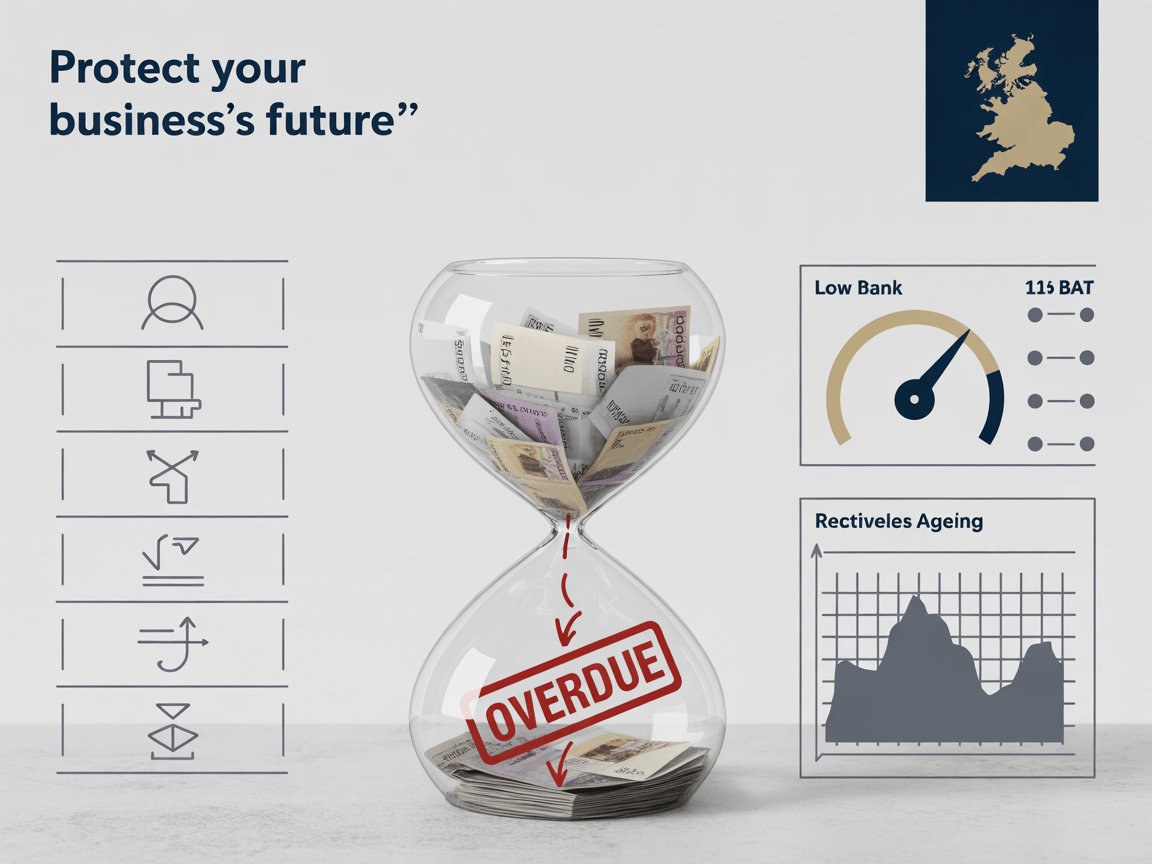Your business could be weeks away from collapse, and you might not even know it.
Sound dramatic? Unfortunately, it’s the reality for thousands of UK business owners right now. Business cash flow problems kill more companies than competition, market downturns, or poor products combined. The terrifying truth is that profitable businesses can fail overnight when cash runs out.
But here’s what gives me hope after two decades of helping businesses navigate financial crises: every cash flow disaster sends warning signals weeks or months before it strikes. The entrepreneurs who survive are those who recognise these signs early and take decisive action.
What you’re about to discover could save your business.
These seven warning signs have appeared in every cash flow crisis I’ve witnessed, and learning to spot them early is the difference between a temporary setback and permanent closure.
Cash Flow Fundamentals: What Every Business Owner Must Understand
Cash flow isn’t about profitability – it’s about timing. You can have an order book complete of profitable contracts and still face business cash flow problems if those payments arrive after your bills are due.
Think of cash flow as the oxygen in your business bloodstream. You can survive without profit for months, even years, but you can’t survive without cash for more than a few weeks. When cash flow stops, everything stops: payroll, supplier payments, rent, and ultimately, operations.
The UK statistics are sobering: 82% of businesses that fail cite cash flow problems as a contributing factor, and 29% of small business failures are directly attributed to running out of cash. These aren’t just numbers – they represent dreams destroyed and livelihoods lost.
But understanding why most businesses fail due to cash flow issues gives us the power to prevent it from happening to yours.

Warning Sign #1: Accounts Receivable Ageing Beyond Terms
When customers start paying later and later, your business is heading for trouble.
The first warning sign appears in your accounts receivable ledger. If you typically offer 30-day payment terms but find customers routinely taking 45, 60, or 90 days to pay, you’re watching a cash flow crisis develop in real time.
I remember working with James, who ran a successful marketing agency. His clients loved his work, he was winning new business regularly, but he noticed payments stretching longer each month. “They always pay eventually,” he told me, “so I didn’t think it was a problem.”
Within six months, James was advancing costs for campaigns whilst waiting 4-5 months for payment. Despite having £150,000 in outstanding invoices, he couldn’t make payroll. His business was profitable on paper but dying from a lack of cash.
Here’s why this warning sign is so dangerous: Once late payments become normalised in your business relationships, you’ve essentially trained your clients that your payment terms are merely suggestions. I’ve watched this happen countless times – what starts as one client taking an extra week to pay quickly spreads throughout your entire customer base.
The psychology is fascinating and terrifying. When you don’t enforce your payment terms consistently, you’re inadvertently communicating that your business doesn’t need the money urgently. Clients interpret this as a sign that you’re financially secure enough to wait, which ironically makes them even more casual about payment timing.
The tipping point arrives when more than 20% of your invoices remain unpaid 10 days beyond your stated terms. At this point, you’re no longer running a business with payment terms – you’re running an unofficial financing company for your clients, and that’s a recipe for disaster.
Warning Sign #2: Increasing Reliance on Credit Facilities
If you’re using credit to pay routine operating expenses, you’re already in the danger zone.
Overdrafts and business credit cards serve legitimate purposes: managing seasonal fluctuations, financing growth opportunities, or covering one-off expenses. But when you’re routinely using credit to pay salaries, rent, or supplier invoices, you’ve moved from strategic borrowing to survival mode.
The progression is predictable and dangerous:
- Month 1: Use overdraft to smooth a temporary cash shortage
- Month 2: Overdraft becomes necessary to make payroll on time
- Month 3: Credit cards cover supplier payments whilst waiting for client payments
- Month 6: All available credit is exhausted, and you’re trapped
Sarah, a retail business owner, experienced this exact pattern. “I told myself it was just a rough patch,” she explained. “But each month, I needed the overdraft a little more, and it never seemed to reduce.”
The compound effect is devastating: Interest payments reduce available cash, creating a downward spiral where you need more credit to service existing debt.
Warning Sign #3: Supplier Payment Delays and Relationship Strain
When you start asking suppliers for extended payment terms or delaying payments, you’re broadcasting financial distress.
Your suppliers become your early warning system because they’ve witnessed this pattern countless times before. They know the signs, they’ve seen businesses fail, and they understand precisely what delayed payments indicate about your financial health.
Watch for these relationship changes, and understand what they really mean. When suppliers start requesting payment on delivery instead of their usual credit terms, they’re not being difficult – they’re protecting themselves from your potential failure. The frequency of payment reminder calls increases because your account has been flagged as higher risk in their system.
Even more telling is when suppliers begin offering “early payment discounts.” This isn’t a generous gesture – it’s a clear signal that they’re worried about getting paid at all and would rather receive 95% of their money today than risk receiving nothing tomorrow.
When key suppliers place your account on hold, you’ve crossed a critical threshold. These are businesses that have worked with you for months or years, and they’ve made the difficult decision that extending further credit to your business represents an unacceptable risk.
Perhaps most concerning is when long-standing suppliers suddenly require deposits for new orders. This represents a fundamental shift in how they view your business – from a trusted partner to a credit risk that requires security before they’ll provide goods or services.
The damage extends far beyond immediate payment issues. Supplier relationships are crucial for business continuity, and once trust is damaged, rebuilding can take years. Some suppliers may never extend credit terms again, forcing you into a cash-only relationship that further strains your working capital.
Here’s the critical threshold: If three or more suppliers express payment concerns in the same month, you’re facing a cash flow crisis, not just temporary difficulties.

Warning Sign #4: Payroll Stress and Staff Payment Issues
The moment you worry about making payroll, your business is in serious trouble.
Nothing strikes fear into a business owner’s heart quite like approaching payday without sufficient funds. This warning sign often appears suddenly, but it indicates deep underlying cash flow problems that have been building for weeks.
Early stages include:
- Checking bank balances daily before payday
- Timing invoice payments to ensure payroll coverage
- Considering paying some staff late or in instalments
- Using personal funds to cover business payroll
Emma, who ran a successful consulting firm, describes the breaking point: “I found myself lying awake at night, calculating whether client payments would arrive before Friday’s payroll. The moment I started considering paying my team late, I knew I was in trouble.”
Staff payment issues create a cascade of problems:
- Legal obligations to pay wages on time
- Potential employment tribunal claims
- Loss of team morale and productivity
- Key staff departures during critical periods
- Reputational damage in your industry
Immediate action required: If you’ve delayed or considered delaying any staff payments, seek professional help immediately.
Warning Sign #5: Personal Financial Stress From Business Demands
When business cash flow problems start affecting your personal finances, you’re approaching the point of no return.
Many entrepreneurs initially fund their businesses personally, but ongoing personal financial stress indicates that their business model isn’t generating sufficient cash to sustain operations.
This manifests as:
- Regularly transferring personal money to cover business expenses
- Using personal credit cards for business purchases
- Delaying personal bills to fund business operations
- Borrowing against personal assets to support the business
- Family financial stress due to business demands
The psychological impact is enormous. You’re not just risking your business – you’re risking your family’s financial security, your home, and your personal credit rating.
David, a restaurant owner, reflects: “I started using our family savings to cover suppliers, telling myself it was temporary. Two years later, we’d spent our house deposit and maxed out personal credit cards. The business was destroying our family’s future.”
Professional guidance becomes essential when business problems threaten personal financial stability. Understanding when you need professional support can prevent personal financial ruin.
Warning Sign #6: Inventory and Asset Management Problems
Difficulty managing inventory levels or being forced to liquidate assets indicates severe cash flow constraints.
Inventory problems signal cash flow stress because:
- Over-ordering ties up cash in unsold stock
- Under-ordering loses sales due to stock-outs
- Supplier credit restrictions force cash purchases
- Seasonal stock becomes a significant cash burden
Asset liquidation is the final warning: When you start selling business assets to fund operations, you’re cannibalising your future earning capacity.
I’ve witnessed businesses sell essential equipment, vehicles, or property to generate immediate cash, only to discover they’ve created bigger problems. Selling productive assets for working capital is rarely a sustainable solution.
Critical indicators:
- Stock levels are consistently too high or too low
- Difficulty obtaining supplier credit for inventory
- Considering selling business equipment or property
- Lease agreements are in default due to payment issues
Warning Sign #7: Decision-Making Paralysis and Emotional Overwhelm
When cash flow stress affects your ability to make clear business decisions, you’re entering the most dangerous phase.
Financial stress creates a psychological spiral:
- Analysis paralysis when facing essential decisions
- Avoiding difficult conversations with suppliers or clients
- Postponing strategic decisions due to cash concerns
- Emotional decision-making rather than logical planning
- Isolation and withdrawal from business networks
This warning sign is particularly insidious because it impairs your ability to solve the very problems causing the stress. Good decision-making is essential for resolving cash flow problems, but stress makes good decisions nearly impossible.
Professional support becomes crucial at this stage. Working with experienced business coaches provides the objective perspective and strategic thinking needed when you’re too close to the problems to see solutions clearly.
Many entrepreneurs find that mastering business decisions under pressure is a skill that not only resolves immediate cash flow problems but also prevents future crises.
How to Tell if a Company is in Trouble: External Warning Signs
Sometimes you need to assess other businesses’ financial health – potential clients, suppliers, or partners.
External warning signs include:
- Consistently late payments to suppliers
- Staff departures, particularly in finance or management
- Reduced marketing and business development activity
- Office downsizing or lease changes
- Avoiding industry events or networking opportunities
- Social media and website updates are becoming infrequent
For potential clients: Request credit checks, ask for deposits, or negotiate shorter payment terms if you spot these signs.
For suppliers: Diversify your supplier base to avoid being affected by their potential failure.
For partners: Protect yourself with clear contracts and regular financial health assessments.
How Can You Tell if a Business is Failing?
Business failure rarely happens overnight – it’s usually a gradual decline with identifiable stages.
| Stage | Key Indicators |
|---|---|
| Stage 1: Performance Decline | • Revenue growth slows or reverses • Profit margins compress due to increased costs • Customer complaints increase • Staff morale deteriorates |
| Stage 2: Financial Stress | • Business cash flow problems become apparent • Credit utilisation increases • Supplier payment delays begin • Investment in growth stops |
| Stage 3: Operational Crisis | • Key staff departures accelerate • Customer service quality deteriorates • Marketing and sales activities reduce • Emergency cost-cutting measures implemented |
| Stage 4: Financial Crisis | • Payroll difficulties arise • Supplier relationships break down • Asset liquidation begins • Professional advisors engaged |
Understanding these stages helps you:
- Assess your own business’s position honestly
- Evaluate potential business partners or clients
- Recognise when to seek professional help
- Take corrective action before reaching the crisis point

How Do I Know When to Walk Away From a Business?
One of the most complex decisions any entrepreneur faces is knowing when to stop fighting and close the business.
Financial Indicators
Consider walking away when:
- Personal financial security is genuinely threatened
- Debt levels exceed realistic repayment capacity
- No viable path to profitability exists within 12 months
- Cost of continuing exceeds potential recovery value
Personal Indicators
Consider your wellbeing:
- Health impacts from business stress
- Family relationships are suffering significantly
- Mental health deteriorating
- No enjoyment or satisfaction from the business
Market Indicators
External factors suggesting closure:
- Fundamental market changes are making your model obsolete
- Competition has established unassailable advantages
- Regulatory changes are making the operation impossible
- Economic conditions are unlikely to recover
The decision to close a business isn’t failure – it’s often the most responsible choice for yourself, your family, and your stakeholders. Many successful entrepreneurs have closed businesses before finding their ultimate success.
Professional guidance helps you make this decision objectively. Understanding what a business coach does and the investment involved can help you determine whether professional support might provide alternatives to closure.
What Does a Failing Company Look Like? The Visible Signs
Failing companies display predictable external characteristics that become apparent to customers, suppliers, and competitors.
Customer Experience Deterioration
- Longer response times to enquiries
- Quality issues that weren’t present previously
- Reduced service levels or product availability
- Staff turnover is affecting customer relationships
Marketing and Communication Changes
- Reduced advertising and promotional activity
- Website updates are becoming infrequent
- Social media engagement is declining
- Industry event participation is decreasing
Operational Visible Changes
- Office or retail space appearing neglected
- Reduction in staff numbers or hours
- Equipment maintenance is being deferred
- Supplier delivery issues affecting operations
Professional Network Withdrawal
- Absence from industry networking events
- Reduced participation in professional associations
- Senior management is becoming less accessible
- Business development activities are stopping
These signs help you:
- Protect your business when dealing with failing companies
- Recognise similar signs in your own business
- Take corrective action before external signs become apparent
- Maintain professional relationships even during difficult periods

How to Tell if a Business is Losing Money: Financial Health Assessment
Profitability problems often precede cash flow problems, making financial health assessment crucial.
Revenue Analysis
- Declining sales trends over 3+ consecutive months
- Reducing average transaction values
- Increasing customer acquisition costs
- Customer retention rates are falling
Cost Structure Problems
- Rising costs without corresponding price increases
- Fixed costs are consuming an increasing percentage of revenue
- Emergency cost-cutting measures are becoming routine
- Deferred maintenance and investment
Margin Compression Indicators
- Gross margins are declining consistently
- Pressure to reduce prices to maintain sales
- Unable to pass cost increases to customers
- Working longer hours for the same or less profit
Cash vs Profit Disconnect
- Profitable on paper but constantly short of cash
- Increasing gap between invoiced sales and cash received
- Growing investment in working capital
- Profit quality deteriorating
Regular financial health assessments prevent minor problems from becoming major crises. Many businesses benefit from monthly financial reviews that track these key indicators alongside cash flow forecasting.
What is the Most Common Business to Fail? Industry Risk Assessment

While any business can face cash flow problems, specific industries have higher failure rates.
Highest Risk Industries
- Restaurants and hospitality (60% failure rate within 5 years)
- Retail businesses (especially clothing and accessories)
- Construction and building trades
- Personal services (salons, fitness, etc.)
- Consulting and professional services (especially solo practitioners)
Why These Industries Struggle
- High fixed costs with variable revenue
- Seasonal demand fluctuations
- Intense competition and price pressure
- Long payment cycles with immediate expenses
- Economic sensitivity affecting discretionary spending
Lower Risk Industries
- Healthcare and medical services
- Essential business services (accounting, legal)
- Education and training
- Technology with recurring revenue models
- Utilities and essential services
Understanding industry risks helps you:
- Set appropriate cash reserves for your sector
- Plan for seasonal variations
- Benchmark against realistic industry standards
- Develop strategies specific to your industry challenges
This is particularly relevant for London startups and female entrepreneurs who often enter competitive markets with limited resources.
When to Let Your Business Go: Making the Difficult Decision

Sometimes the most courageous decision is knowing when to stop.
Objective Decision Criteria
Consider closure when:
- Three consecutive quarters of declining revenue with no recovery plan
- Debt-to-asset ratio exceeding industry norms with no improvement path
- Personal financial guarantees threaten family security
- Market conditions have permanently changed against your business model
The Emotional vs Financial Decision
Separate emotion from facts:
- Sunk cost fallacy: Don’t continue just because you’ve already invested
- False hope: Distinguish between realistic recovery and wishful thinking
- Family impact: Consider effects on personal relationships and security
- Opportunity cost: What else could you do with your time and remaining resources?
Professional Closure vs Emergency Closure
Plan closure properly:
- Staff redundancy handled legally and ethically
- Supplier obligations managed respectfully
- Customer commitments fulfilled where possible
- Asset disposal maximised for creditor benefit
Emergency closure often destroys relationships and creates additional liabilities that follow you for years.
How Most Small Businesses Fail: The Typical Trajectory
Understanding the typical failure pattern helps you intervene before it’s too late.
The Standard Failure Timeline
| Timeline | Key Indicators |
|---|---|
| Months 1-6: Warning Signs Appear | • Cash flow irregularities begin • Payment terms start extending • Credit utilisation increases • Stress levels rise |
| Months 7-12: Problems Compound | • Multiple warning signs are present simultaneously • Professional relationships begin to strain • Personal financial stress increases • Decision-making quality deteriorates |
| Months 13-18: Crisis Point | • Payroll difficulties arise • Supplier relationships break down • Asset liquidation consideration • Professional advice sought (often too late) |
| Months 19-24: Final Phase | • All options exhausted • Formal insolvency procedures begin • Business closure becomes inevitable • Personal financial impact realised |
Intervention Points
Early intervention (Months 1-6): Problem-solving and cash flow management. Mid-stage intervention (Months 7-12): Restructuring and professional support. Late intervention (Months 13-18): Crisis management and negotiation. Final stage (Months 19-24): Damage limitation and closure planning
The earlier you intervene, the more options you have.
This is why recognising early warning signs and seeking help promptly can save your business.
What is the Average Lifespan of a Company? Realistic Expectations
Understanding business lifespans helps set realistic expectations and plan accordingly.
UK Business Survival Statistics
- 1 year: 80% of businesses survive
- 3 years: 50% still operating
- 5 years: 20% remain viable
- 10 years: 10% achieve long-term success
Factors Affecting Lifespan
- Industry sector: Some industries naturally have shorter lifecycles
- Initial funding: Adequate capitalisation extends survival chances
- Management experience: Previous business experience significantly improves odds
- Market timing: Launching during favourable conditions helps
- Professional support: Business coaching and advice improve survival rates
Improving Your Odds
Businesses that exceed average lifespans typically:
- Plan thoroughly before launching
- Maintain adequate cash reserves
- Seek professional advice early
- Build strong customer relationships
- Adapt to changing market conditions
- Invest in management development
The difference between businesses that fail within five years and those that thrive for decades often comes down to the quality of decision-making during crisis periods and the willingness to seek help before problems become overwhelming.
Taking Action: Your Next Steps
Recognising these warning signs is only valuable if you act upon them.
If you’ve identified any of these warning signs in your business, immediate action is essential. Cash flow problems don’t resolve themselves – they require deliberate intervention and often professional guidance.
The businesses that survive financial crises are those that face reality quickly, seek appropriate help, and implement necessary changes before options become limited.
Whether you need strategic planning, cash flow management, or crisis intervention, the key is acting while you still have choices. The entrepreneurs who wait until they have no alternatives often find it’s too late to save their businesses.
Your business doesn’t have to become another failure statistic. With proper recognition of warning signs, professional support, and decisive action, even severe cash flow problems can be resolved.
The question isn’t whether you’ll face financial challenges – every business does. The question is whether you’ll recognise them early and respond effectively. Your business’s survival may depend on the decisions you make in the next few weeks.





